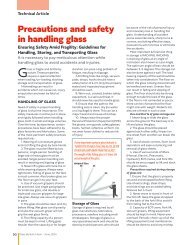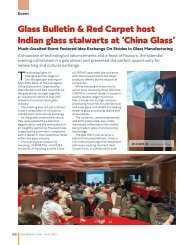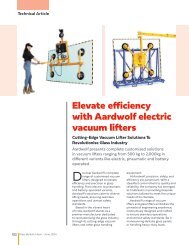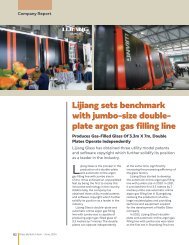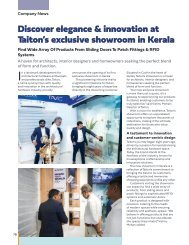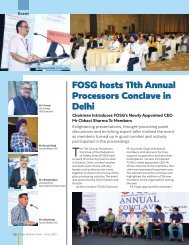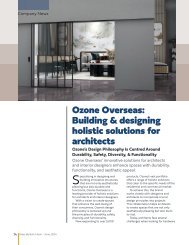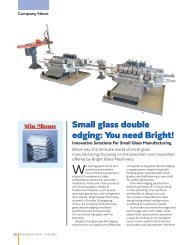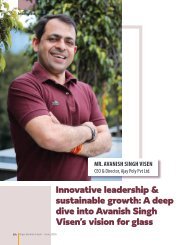Forel introduces Thermoplastic spacer applicator
Revolutionising Insulating Glass Production With Precision & Efficiency Forel brings Thermoplastic spacer applicator to complete the range of solutions dedicated to the production of insulating glass.
Revolutionising Insulating Glass Production With Precision & Efficiency
Forel brings Thermoplastic spacer applicator to complete the range of solutions dedicated to the production of insulating glass.
- No tags were found...
You also want an ePaper? Increase the reach of your titles
YUMPU automatically turns print PDFs into web optimized ePapers that Google loves.
Company News<br />
<strong>Forel</strong> <strong>introduces</strong><br />
<strong>Thermoplastic</strong><br />
<strong>spacer</strong> <strong>applicator</strong><br />
Revolutionising Insulating Glass Production With<br />
Precision & Efficiency<br />
<strong>Forel</strong> brings <strong>Thermoplastic</strong> <strong>spacer</strong> <strong>applicator</strong> to complete<br />
the range of solutions dedicated to the production of<br />
insulating glass.<br />
To complete the range of<br />
solutions dedicated to the<br />
production of insulating<br />
glass, <strong>Forel</strong> has introduced the<br />
<strong>Thermoplastic</strong> <strong>spacer</strong> <strong>applicator</strong><br />
in the IG line. The <strong>applicator</strong><br />
plays a crucial role in the process,<br />
tasked with accurately pumping<br />
<strong>Thermoplastic</strong> material from the<br />
barrel and extruding it directly onto<br />
the glass plates. Comprising several<br />
key components, the <strong>applicator</strong><br />
module includes several elements.<br />
First of all, a high-performance<br />
heated Graco pump ensures a<br />
continuous flow of material by<br />
feeding a storage reservoir, thereby<br />
facilitating uninterrupted extrusion<br />
even during drum changes.<br />
A dual volumetric dosing system<br />
driven by servo motors is utilized,<br />
enabling precise control over the<br />
amount of material dispensed.<br />
A specially designed nozzle<br />
ensures precise application of the<br />
material onto the glass surface.<br />
Also, a precise multipoint heated<br />
delivery system is implemented,<br />
maintaining the material at an<br />
optimal application temperature<br />
ranging from 120°C to 130°C.<br />
CNC-controlled application,<br />
with three-axis movement, allows<br />
for precise and programmable<br />
application patterns tailored to<br />
specific requirements.<br />
Finally, the integration of a<br />
synchronized, dynamic suction cup<br />
mechanism ensures a controlled<br />
conveyance of the glass plates during<br />
the application process, enhancing<br />
precision and consistency.<br />
Together, these elements form<br />
a sophisticated <strong>applicator</strong> system<br />
capable of delivering precise, highquality<br />
application of <strong>Thermoplastic</strong><br />
material onto glass plates, meeting<br />
the stringent standards of the<br />
industry.<br />
The pumping system for<br />
thermoplastic employed by <strong>Forel</strong><br />
is integral to the manufacturing<br />
process, ensuring precise and<br />
efficient application onto glass<br />
surfaces. Here’s an overview of its<br />
components and functionalities:<br />
The main Graco Pump System,<br />
with a robust 200-litre capacity<br />
stock, serves as the primary<br />
76 Glass Bulletin | April - June, 2024
FOREL SPA • 2<br />
component, securely affixed to <strong>Forel</strong>’s<br />
pneumatic/hydraulic frame and<br />
barrel support structure. This system<br />
provides the necessary force to pump<br />
the thermoplastic material through<br />
the production line.<br />
The heated thermal drum jacket,<br />
integrated directly into the machine,<br />
plays a crucial role in maintaining a<br />
consistent and optimal temperature<br />
for the thermoplastic material stored<br />
in barrels. This ensures smooth<br />
extrusion and application onto the<br />
glass plates.<br />
At this stage, the main drum pump<br />
channels the <strong>Thermoplastic</strong> material<br />
directly into the onboard reservoir<br />
system, ensuring a continuous and<br />
steady supply during the production<br />
process.<br />
Comprising two 7-litre cylindrical<br />
storage containers linked to a<br />
hydraulic pump, the reservoir pump<br />
system serves as a backup, providing<br />
a total reserve capacity of 14 litres.<br />
This setup allows for approximately<br />
30 minutes of continuous material<br />
extrusion under typical operating<br />
conditions, ensuring uninterrupted<br />
workflow.<br />
Characterised by precision and<br />
accuracy, the dosing system consists<br />
of two 0.6-litre cylindrical storage<br />
containers driven by servo motors.<br />
This system precisely controls the<br />
volume of <strong>Thermoplastic</strong> material<br />
dispensed, ensuring consistent<br />
application onto the glass surfaces.<br />
Directly connected to the application<br />
nozzle, it facilitates smooth and<br />
controlled material flow, resulting in<br />
high-quality finishes.<br />
The Nozzle<br />
Achieving a hermetically sealed<br />
start and finish point for the <strong>spacer</strong><br />
application is paramount to ensuring<br />
the high quality and durability of the<br />
thermoplastic Insulated Glass (IG)<br />
unit. Here are the key features and<br />
benefits of the sealing process:<br />
The joint closing process utilizes<br />
a well-established wedge joint<br />
method, ensuring a gas-tight seal<br />
that remains secure throughout the<br />
lifespan of the IG unit. This minimizes<br />
the loss of gas over time, contributing<br />
to its longevity and performance.<br />
With no requirement for secondary<br />
touch-ups, the sealed joints maintain<br />
their integrity without the need for<br />
additional interventions. This reduces<br />
maintenance efforts and enhances<br />
operational efficiency.<br />
The sealing process delivers<br />
consistent reliability and aesthetic<br />
appeal, with no tooling marks or<br />
inconsistencies. This results in a<br />
uniform and professional finish that<br />
meets stringent quality standards.<br />
Versatility: The sealed joints can<br />
be positioned in corners or offset on<br />
edges, offering flexibility in design<br />
and application to suit various<br />
architectural requirements and<br />
preferences.<br />
Moreover, the nozzle design<br />
enhances efficiency and assembly<br />
times:<br />
Material Reduction: Compared to<br />
typical standard nozzles, the nozzle<br />
design reduces material usage,<br />
optimizing resource utilization and<br />
minimizing waste. This contributes<br />
to cost savings and environmental<br />
sustainability.<br />
Reduced Assembly Times:<br />
Assembly times are significantly<br />
reduced by over 20% compared to<br />
standard IGU equipment from <strong>Forel</strong>,<br />
thanks to the nozzle’s innovative<br />
design and improved efficiency.<br />
Width and Radius Optimization:<br />
The nozzle widths and corner radius<br />
are optimized to improve sightlines<br />
and reduce the <strong>spacer</strong> profile<br />
height to 5.3 mm, enhancing the<br />
aesthetic appeal of the IG units while<br />
maintaining structural integrity.<br />
Overall, the sealing process<br />
and nozzle design represent<br />
advancements in thermoplastic IG<br />
unit technology, offering improved<br />
performance, efficiency, and<br />
aesthetics for the flat glass and<br />
insulated glass industry.<br />
---------------------------------------<br />
For enquiries on <strong>Forel</strong> products in<br />
India, please write to Thorngate Sales<br />
Corp at sales@thorngate.in<br />
---------------------------------------<br />
Email: info@forelspa.com<br />
Website: www.forelspa.com<br />
Glass Bulletin | April - June, 2024<br />
77




